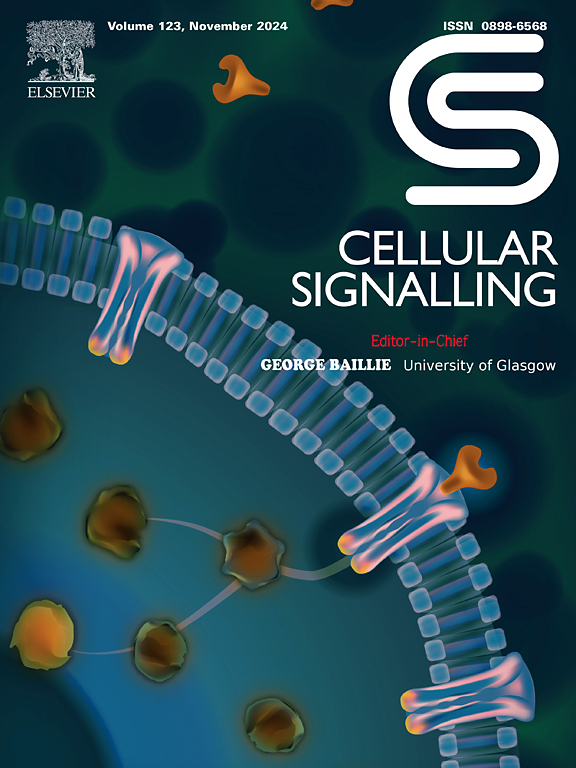SOX12在子宫内膜癌中促进丝氨酸合成和肿瘤进展。
IF 4.4
2区 生物学
Q2 CELL BIOLOGY
引用次数: 0
摘要
研究表明,性别决定区Y-box 12 (SOX12)是一种关键的癌基因,在多种肿瘤中高表达,并与不良预后相关。不幸的是,SOX12在子宫内膜癌(EC)中的作用尚不清楚。在这里,我们发现SOX12在晚期患者和死亡患者的EC组织中表达显著升高。此外,SOX12的高表达可预测较差的总生存期(OS)和无复发生存期(RFS),表明SOX12是EC患者的独立预后因素。此外,SOX12的过表达或低表达均显著增强或抑制EC细胞的活性、增殖、迁移、侵袭能力、丝氨酸合成途径(SSP)活性和代谢。此外,过表达SOX12显著促进了皮下移植肿瘤的生长和恶性进展,促进了肺转移结节的形成,最终降低了裸鼠的生存时间。相比之下,稳定抑制SOX12可显著抑制经尾静脉引入的皮下移植物的生长和肺转移结节的形成,同时也可延长裸鼠的生存时间。机制上,SOX12直接结合靶基因3-磷酸甘油酸脱氢酶(3-phosphoglycerate dehydrogenase, PHGDH)启动子,激活其转录,增强SSP和代谢,最终导致EC的恶性进展。令人惊讶的是,我们发现丝氨酸剥夺和SOX12敲低的结合在体内和体外抑制EC的恶性进展方面具有更明显的效果。总之,我们的研究不仅增强了对SOX12相关致癌机制的理解,而且为EC的分子靶向治疗提供了潜在的策略。本文章由计算机程序翻译,如有差异,请以英文原文为准。
SOX12 promotes serine synthesis and tumor progression in endometrial cancer
Studies have demonstrated that the sex-determining region Y-box 12 (SOX12), a key oncogene, is highly expressed in various tumors and is associated with poor prognosis. Unfortunately, the effect of SOX12 in endometrial cancer (EC) remains unclear. Here, we discovered that SOX12 expression was significantly elevated in EC tissues from advanced-stage patients and patients who died. Additionally, high expression of SOX12 was shown to predict poor overall survival (OS) and recurrence-free survival (RFS), indicating that SOX12 is an independent prognostic factor for patients with EC. Furthermore, the overexpression or knockdown of SOX12 significantly enhanced or inhibited the activity, proliferation, migration, invasion ability, serine synthesis pathway (SSP) activity and metabolism, respectively, of EC cells. Moreover, overexpression of SOX12 significantly promoted the growth and malignant progression of subcutaneously transplanted tumors, facilitated the formation of lung metastatic nodules, and ultimately reduced the survival time of nude mice. In contrast, stable suppression of SOX12 markedly inhibited the growth of subcutaneous grafts and the formation of lung metastatic nodules in introduced via the tail vein, while also increasing the survival time of nude mice. Mechanistically, SOX12 directly binds to the promoter of the target gene 3-phosphoglycerate dehydrogenase (PHGDH), activating its transcription and enhancing the SSP and metabolism, which ultimately contributes to the malignant progression of EC. Surprisingly, we found that the combination of serine deprivation and SOX12 knockdown had a more pronounced effect on inhibiting the malignant progression of EC in vivo and in vitro. In summary, our study not only enhances the understanding of the carcinogenic mechanisms associated with SOX12 but also presents a potential strategy for molecularly targeted therapy in EC.
求助全文
通过发布文献求助,成功后即可免费获取论文全文。
去求助
来源期刊

Cellular signalling
生物-细胞生物学
CiteScore
8.40
自引率
0.00%
发文量
250
审稿时长
27 days
期刊介绍:
Cellular Signalling publishes original research describing fundamental and clinical findings on the mechanisms, actions and structural components of cellular signalling systems in vitro and in vivo.
Cellular Signalling aims at full length research papers defining signalling systems ranging from microorganisms to cells, tissues and higher organisms.
 求助内容:
求助内容: 应助结果提醒方式:
应助结果提醒方式:


